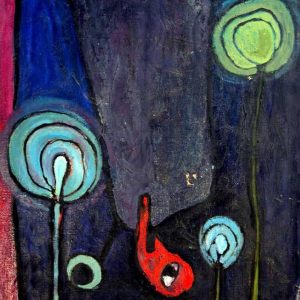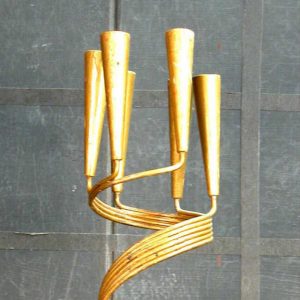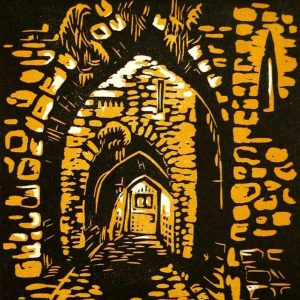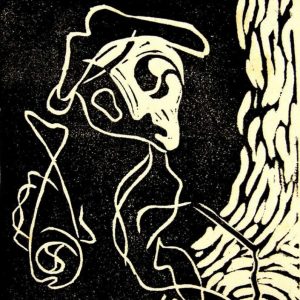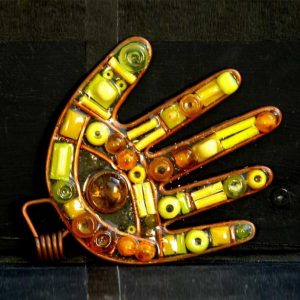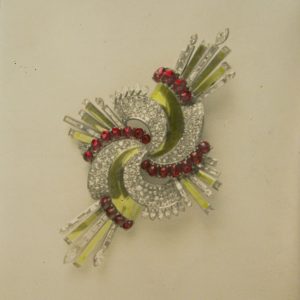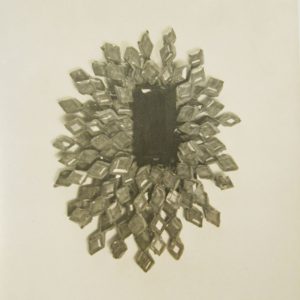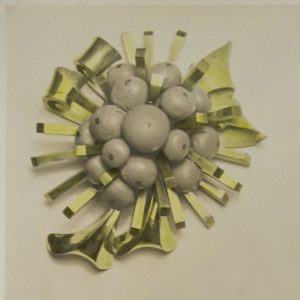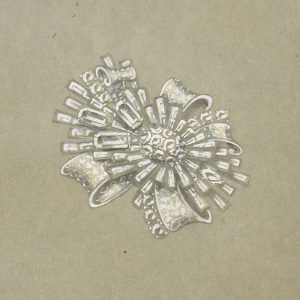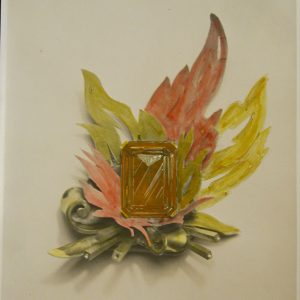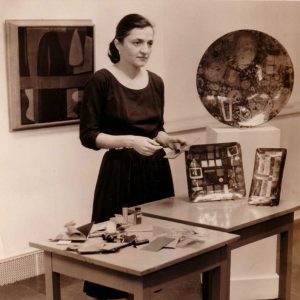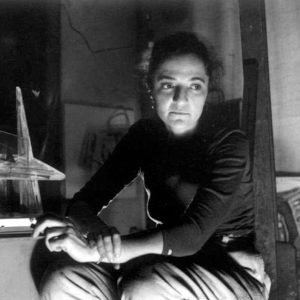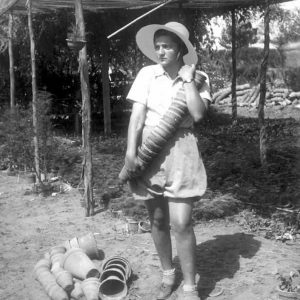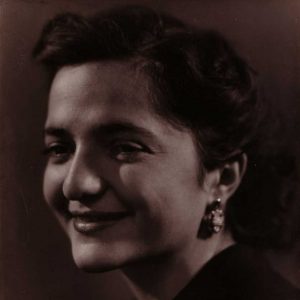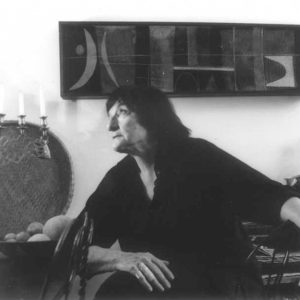


Zahara Sando Schatz (1916–1999)
Zahara was born in Jerusalem in 1916, the daughter of Dr. Olga Schatz and Prof. Boris Schatz, the founder of Bezalel.
After completing her studies at the Hebrew High School in Jerusalem, she went on to study art in Paris. Along with her involvement in different artistic disciplines, Zahara also taught art in Israel and the United States and served as a consultant of industrial design for the Ministry of Industry and Commerce.
She received many awards throughout her career: the Dizengoff Award for Art, the Yad Vashem Award, New York's Museum of Modern Art (MOMA) Award for Art, and Milan's Gold Award. In 1955 she was awarded the Israel Prize in the Arts.
Zahara had numerous solo exhibitions featuring her work in Israel and abroad, in places such as the Tel Aviv Museum of Art, the Artists' House in Jerusalem, and the San Francisco Museum of Modern Art. In addition, her work has been featured in museums and galleries throughout the world as part of many group exhibitions.
Her signature works include walls, panels, holy artifacts, mobiles, doors, etc. Such pieces were featured throughout Israel and across the globe, in places including Abidjan, Ivory Coast; Atlantic City; the Dan Carmel Hotel in Haifa; El Al in London; Yad Vashem; Hadassah Hospital in Ein Kerem; and the Hebrew University on Mt. Scopus.
Zahara Schatz was the last of the Schatz dynasty. She passed away in Jerusalem in 1999 at the age of 83.
"…Ever since her childhood, Zahara Schatz fell in love with art and the process of creating art with her hands. In her father's, Prof. Boris Schatz's house in Jerusalem, there was an artistic and pioneering spirit. As a young girl, her hands were always busy. Such was the house: it was a house of work, a house which never tired, a house which did not know how to stop or rest. This pioneering spirit, which Schatz imparted to his children and students, still lives on today. Several years after her father's death, Zahara, accompanied by her mother and brother, Bezalel, traveled to Europe and later to the United States, where she lived during World War II, in order to study and train in the arts. Zahara Schatz, as a daughter of her age, imbibing a pioneering spirit which was inherited from her father, devoted herself to a new type of artistic creation using a unique sculpting method, akin to vitrage (stained glass mosaic), which aims at enhancing the esthetics of cheap material, and convert serviceable goods into art. Connecting plastic, along with a variety of different types of metals, copper, fliz, and also iron, took advantage of the lucidity of the material in order to create "Medieval forms" - in the style of beaten metal, netting, beaten silver, and even leaves and flowers placed between two sheets of plastic. In so doing, a transformation of dead, muted materials into vibrant, vocal ones occurred. And since this new material was best served in abstract pieces, Zahara exhibited in them her true creative, artistic force. Zahara tried to create art pieces using plastic which, due to their abstract nature, appear to us as sounds, as colorful musical chords which delight our eyes. From the day she returned to Israel, Zahara took an active role in the imagery of practical shapes for the sake of tasteful art, and the results of this activity are most encouraging. They have effectively restored Israel's place among the global arts community, by earning respect for Israel's artistic works. Indeed, her handicraft and imaginative creations are innovative projects even among the global arts community. Upon her return from the United States, she was awarded prizes for her works and thus, during the Israeli Practical Arts Exhibition, she received the Schatz Award for her artwork using plastic. It is a joy to know that Zahara began her career at a time when her father's work was coming to an end - Prof. Boris Schatz, a true pioneer of the arts in this country. This continuation of his legacy is invaluable for us…"
Zahara Sando Schatz (1916–1999)
Zahara was born in Jerusalem in 1916, the daughter of Dr. Olga Schatz and Prof. Boris Schatz, the founder of Bezalel.
After completing her studies at the Hebrew High School in Jerusalem, she went on to study art in Paris. Along with her involvement in different artistic disciplines, Zahara also taught art in Israel and the United States and served as a consultant of industrial design for the Ministry of Industry and Commerce.
She received many awards throughout her career: the Dizengoff Award for Art, the Yad Vashem Award, New York's Museum of Modern Art (MOMA) Award for Art, and Milan's Gold Award. In 1955 she was awarded the Israel Prize in the Arts.
Zahara had numerous solo exhibitions featuring her work in Israel and abroad, in places such as the Tel Aviv Museum of Art, the Artists' House in Jerusalem, and the San Francisco Museum of Modern Art. In addition, her work has been featured in museums and galleries throughout the world as part of many group exhibitions.
Her signature works include walls, panels, holy artifacts, mobiles, doors, etc. Such pieces were featured throughout Israel and across the globe, in places including Abidjan, Ivory Coast; Atlantic City; the Dan Carmel Hotel in Haifa; El Al in London; Yad Vashem; Hadassah Hospital in Ein Kerem; and the Hebrew University on Mt. Scopus.
Zahara Schatz was the last of the Schatz dynasty. She passed away in Jerusalem in 1999 at the age of 83.
"…Ever since her childhood, Zahara Schatz fell in love with art and the process of creating art with her hands. In her father's, Prof. Boris Schatz's house in Jerusalem, there was an artistic and pioneering spirit. As a young girl, her hands were always busy. Such was the house: it was a house of work, a house which never tired, a house which did not know how to stop or rest. This pioneering spirit, which Schatz imparted to his children and students, still lives on today. Several years after her father's death, Zahara, accompanied by her mother and brother, Bezalel, traveled to Europe and later to the United States, where she lived during World War II, in order to study and train in the arts. Zahara Schatz, as a daughter of her age, imbibing a pioneering spirit which was inherited from her father, devoted herself to a new type of artistic creation using a unique sculpting method, akin to vitrage (stained glass mosaic), which aims at enhancing the esthetics of cheap material, and convert serviceable goods into art. Connecting plastic, along with a variety of different types of metals, copper, fliz, and also iron, took advantage of the lucidity of the material in order to create "Medieval forms" - in the style of beaten metal, netting, beaten silver, and even leaves and flowers placed between two sheets of plastic. In so doing, a transformation of dead, muted materials into vibrant, vocal ones occurred. And since this new material was best served in abstract pieces, Zahara exhibited in them her true creative, artistic force. Zahara tried to create art pieces using plastic which, due to their abstract nature, appear to us as sounds, as colorful musical chords which delight our eyes. From the day she returned to Israel, Zahara took an active role in the imagery of practical shapes for the sake of tasteful art, and the results of this activity are most encouraging. They have effectively restored Israel's place among the global arts community, by earning respect for Israel's artistic works. Indeed, her handicraft and imaginative creations are innovative projects even among the global arts community. Upon her return from the United States, she was awarded prizes for her works and thus, during the Israeli Practical Arts Exhibition, she received the Schatz Award for her artwork using plastic. It is a joy to know that Zahara began her career at a time when her father's work was coming to an end - Prof. Boris Schatz, a true pioneer of the arts in this country. This continuation of his legacy is invaluable for us…"





